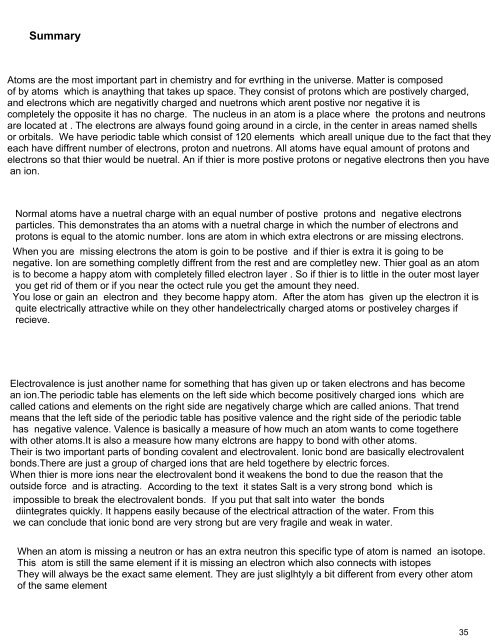You also want an ePaper? Increase the reach of your titles
YUMPU automatically turns print PDFs into web optimized ePapers that Google loves.
Summary<br />
Atoms are the most important part in chemistry and for evrthing in the universe. Matter is composed<br />
of by atoms which is anaything that takes up space. They consist of protons which are postively charged,<br />
and electrons which are negativitly charged and nuetrons which arent postive nor negative it is<br />
completely the opposite it has no charge. The nucleus in an atom is a place where the protons and neutrons<br />
are located at . The electrons are always found going around in a circle, in the center in areas named shells<br />
or orbitals. We have periodic table which consist of 120 elements which areall unique due to the fact that they<br />
each have diffrent number of electrons, proton and nuetrons. All atoms have equal amount of protons and<br />
electrons so that thier would be nuetral. An if thier is more postive protons or negative electrons then you have<br />
an ion.<br />
Normal atoms have a nuetral charge with an equal number of postive protons and negative electrons<br />
particles. This demonstrates tha an atoms with a nuetral charge in which the number of electrons and<br />
protons is equal to the atomic number. Ions are atom in which extra electrons or are missing electrons.<br />
When you are missing electrons the atom is goin to be postive and if thier is extra it is going to be<br />
negative. Ion are something completly diffrent from the rest and are completley new. Thier goal as an atom<br />
is to become a happy atom with completely filled electron layer . So if thier is to little in the outer most layer<br />
you get rid of them or if you near the octect rule you get the amount they need.<br />
You lose or gain an electron and they become happy atom. After the atom has given up the electron it is<br />
quite electrically attractive while on they other handelectrically charged atoms or postiveley charges if<br />
recieve.<br />
Electrovalence is just another name for something that has given up or taken electrons and has become<br />
an ion.The periodic table has elements on the left side which become positively charged ions which are<br />
called cations and elements on the right side are negatively charge which are called anions. That trend<br />
means that the left side of the periodic table has positive valence and the right side of the periodic table<br />
has negative valence. Valence is basically a measure of how much an atom wants to come togethere<br />
with other atoms.It is also a measure how many elctrons are happy to bond with other atoms.<br />
Their is two important parts of bonding covalent and electrovalent. Ionic bond are basically electrovalent<br />
bonds.There are just a group of charged ions that are held togethere by electric forces.<br />
When thier is more ions near the electrovalent bond it weakens the bond to due the reason that the<br />
outside force and is atracting. According to the text it states Salt is a very strong bond which is<br />
impossible to break the electrovalent bonds. If you put that salt into water the bonds<br />
diintegrates quickly. It happens easily because of the electrical attraction of the water. From this<br />
we can conclude that ionic bond are very strong but are very fragile and weak in water.<br />
When an atom is missing a neutron or has an extra neutron this specific type of atom is named an isotope.<br />
This atom is still the same element if it is missing an electron which also connects with istopes<br />
They will always be the exact same element. They are just sliglhtyly a bit different from every other atom<br />
of the same element<br />
35



